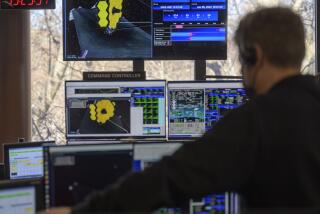Northrop Says It Will Cut 2,700 Jobs in Southland
Northrop will eliminate 3,000 of its 41,000 jobs through layoffs and attrition this year, primarily from its already depressed Southern California aerospace operations, the firm said Wednesday.
The company did not release a breakdown of how the cutbacks will affect each of its locations but said about 2,700 jobs would be lost at its Los Angeles and Ventura County operations that produce the B-2 bomber, the aft section of the F-18 fighter jet, drone jets and guidance systems.
The B-2 bomber division will eliminate a net balance of 500 jobs. The company will actually add jobs at its B-2 final assembly plant in Palmdale but cut significant numbers of jobs at its parts fabrication facility in Pico Rivera.
Northrop’s announcement of upcoming layoffs, made at the company’s annual shareholders meeting Wednesday, compounds an already bleak aerospace outlook in Southern California, where virtually every major prime contractor has taken a large employment hit in recent months.
“That is the unfortunate reality of defense budget reductions,” Northrop President Kent Kresa told shareholders. But he said the Los Angeles-based firm will “stay in the defense business because we bring special capabilities to that business.”
Northrop officials said they did not have any estimate of how much the company will save by eliminating the 3,000 jobs. Kresa said most of the jobs involve administrative or overhead functions and are not directly connected to weapons programs.
Last year, Northrop eliminated 2,500 jobs in another effort to improve its efficiency. Kresa predicted at the meeting that Northrop would sharply improve its profitability in future years.
The current round of job reductions is intended mainly to streamline operations and increase efficiency, a company spokesman said, meaning that the layoffs will only partly reflect federal budget cuts in past years. Current congressional pressure for even steeper reductions in Pentagon spending could lead to further job reductions later on.
Defense Secretary Dick Cheney last month proposed cutting production of the B-2 bomber from the 132 originally planned to only 75 and substantially cutting the peak production rate to 12 per year. He also delayed by two years the proposed start of production for the Air Force’s advanced tactical fighter program, in which Northrop is competing against Lockheed.
Kresa tempered the bad news by announcing that the firm will conduct the full-scale development for the Air Force advanced tactical fighter program in Pico Rivera if it wins the competition against Lockheed for the contract. A winner is to be selected next year.
Kresa also said Northrop plans to produce the fighter in Southern California if it wins the program, but he declined to identify a precise location for “competitive reasons.” The program could easily employ more than 10,000 workers.
Last week, Lockheed disclosed that if it wins the program it would develop and build the aircraft in Marietta, Ga., citing the potential for saving $75 million in annual operating costs in Georgia versus the original plan to build the aircraft in Palmdale.
Lockheed executives were quoted by Georgia newspapers as saying that workers there are “more responsible and ethical” and that “political considerations were a factor,” referring to the influence of Sen. Sam Nunn (D-Ga.), chairman of the Senate Armed Services Committee.
A Lockheed spokesman said Wednesday that the executives were “misquoted” by two separate newspapers.
Nonetheless, Lockheed’s decision to pull out of Southern California and Northrop’s to remain have the potential to set up a geographic and political rivalry that would further complicate the $79-billion advanced tactical fighter program.
“I would imagine as tight as things are, the companies are just looking for the most efficient way to build the product and win the competition,” said Bernard Randolph, a recently retired Air Force general in charge of procurement who now works for TRW. “I am not saying that politics plays no part. It always plays a part, but they can’t gamble just on politics.”
Even if Nunn is unlikely to interfere in the selection process, Lockheed could benefit greatly later in the program from Nunn’s backing of the advanced tactical fighter program if it were located in his home state.
Kresa declined to speculate on what factors led Lockheed to move from Los Angeles County, but he added that Northrop “has done well here” and sees many advantages to locating a major aircraft program in Southern California.
Kresa added that Northrop has the “most modern aircraft development and production facilities in the nation” in Pico Rivera and surmised that if even if Lockheed can gain advantage from lower wage rates in Georgia it will have to invest a lot of money to create a modern facility there.
Kresa said Northrop is seeking to earn a return of more than 10% on its shareholder equity, meaning that it could post profits of $163 million this year, a sharp improvement over its $80.5 million loss in 1989.
He also said the company is considering the sale of additional “non-productive” assets. It already has sold its Century City headquarters building and a production plant in Anaheim.
“I was encouraged by his comments,” said Lawrence Harris, an analyst at Bateman Eichler, Hill Richards.
The company stock, which has been falling sharply in recent years, was up 12.5 cents to $17.50 in trading Wednesday.
More to Read
Inside the business of entertainment
The Wide Shot brings you news, analysis and insights on everything from streaming wars to production — and what it all means for the future.
You may occasionally receive promotional content from the Los Angeles Times.











